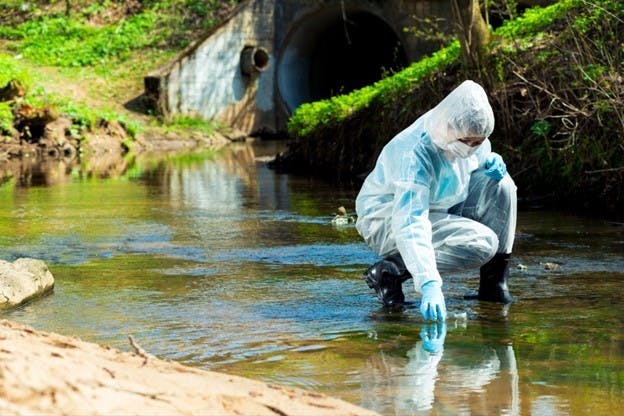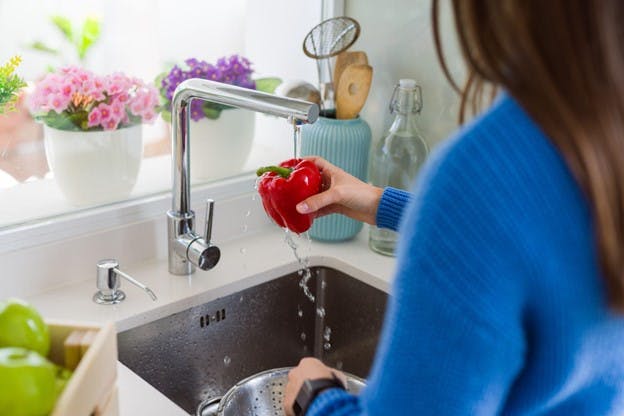🌟 New Arrival! Upgrade Your Water with Our Advanced Pitcher Filter. Shop Now
November 2023
Avoiding the 9 Most Common Waterborne Diseases
When it comes to public health, there’s nothing more important than giving everyone access to clean drinking water. While the water pumped into your home may not be perfect, we’ve come a long way from the days of waterborne diseases like cholera and typhoid fever being common threats in much of the world.
In fact, most people probably don’t spend much time thinking about waterborne illness at all — but they're still out there. In the United States, around seven million waterborne illnesses are reported each year, with 120,000 hospitalizations. Worldwide, the numbers are much bigger. Dysentery alone accounts for 165 million illnesses annually across the globe.
So, what are all these waterborne diseases, and are they as scary as they sound? In this article, we’re going to take a deep dive into the many waterborne diseases out there. We’ll tell you what they are, how dangerous they are, and how you can avoid contracting them.
What Are Waterborne Diseases?
Waterborne diseases are illnesses caused by microorganisms like bacteria and viruses found in water. These diseases are usually contracted through drinking water or recreational water activities. Swimming pools, hot tubs, and polluted beaches, lakes, and rivers are common sources of waterborne disease outbreaks. Drinking from an untreated water source is also a common way to come in contact with waterborne pathogens.
While many of these infectious diseases aren’t the death sentence they were in the early 20th century, they are still extremely dangerous for young kids, the elderly, and anyone with a compromised immune system. According to the U.S. Centers for Disease Control and Prevention, 7,000 people in the U.S. die of waterborne illnesses each year.
Are Waterborne Diseases Contagious?
Many waterborne diseases are contagious because they come from viruses, bacteria, and parasites that are actively seeking new hosts to infect. They can easily spread from person to person or even from animals to people. This can happen in a few ways:
- Touch: If someone who's sick doesn't wash their hands well, they can pass the germs to others. This is especially true if they're handling food or during intimate contact.
- Air: Sometimes, breathing in tiny, contaminated water droplets can get you sick too.
- Shared environments: The ingestion of food and water that has been contaminated by waterborne pathogens can spread these diseases. Traces of contaminated fecal matter on surfaces can also cause more spread as well.
Healthcare experts agree that washing your hands often and practicing good hygiene can reduce the risk of these and other illnesses spreading.
What Are the 9 Most Common Waterborne Diseases?
Since the introduction of modern water disinfection techniques like chlorine and chloramines and ultraviolet light, waterborne diseases have not been nearly as big a threat as they once were. Unfortunately, we’re not out of the woods just yet. Aging infrastructure, pollution, drug resistance, and climate change are increasing the prevalence of many of the waterborne illnesses mentioned below.
1. Typhoid Fever
Typhoid fever is a global threat but mainly affects developing nations with poor sanitation. The disease is caused by the Salmonella typhi bacteria and can be foodborne as well as waterborne. Typhoid is highly contagious. Symptoms include:
- High fever and sweating
- Abdominal pain and headaches
- Muscle weakness
- Diarrhea and constipation
There are vaccines that can lower the risk of getting typhoid fever, and it can be treated with antibiotics. Without treatment, it can be life threatening.
2. Cholera
Cholera is a bacterial disease triggered by exposure to Vibrio cholerae. Like typhoid, it's most common in areas with dense populations, high poverty, and poor sanitation. Cholera is particularly dangerous because the severe dehydration and diarrhea it causes can be fatal for an otherwise healthy person in a matter of hours. Luckily, not everyone experiences symptoms, and cholera is easily treated. Symptoms of cholera include:
- Dehydration
- Diarrhea
- Vomiting and nausea
- Muscle cramps
- Shriveled skin
- Shock
Cholera is rare in the U.S. and Canada, but it still occurs. Practicing good hygiene and food safety minimizes your chances of getting cholera. There is also a vaccine you can take if you are traveling to places where it is more of a threat.
3. Giardiasis (Giardia Infection)
Giardiasis is an intestinal infection that's mainly caused by the protozoan parasite Giardia lamblia. Unlike some of the others on this list, giardiasis is fairly common in the United States. It can be contracted in surface water like lakes and streams, shared swimming pools, spas, private well water, and even public water supplies. It can also be spread through food and sexual contact. Symptoms include:
- Foul smelling diarrhea
- Fatigue
- Cramps and bloating
- Lactose intolerance (possibly long-term)
There’s no vaccine for giardiasis. Treatment usually involves an anti-parasite drug. To avoid giardiasis, wash your hands often, clean your produce, make sure not to swallow water when swimming, don’t drink untreated water, and practice safe sex.
4. Dysentery (Shigellosis)
Dysentery is a form of severe diarrhea that’s caused by the Shigella bacteria and some amoebae. About 450,000 cases per year are reported in the U.S., but there are over 150 million cases worldwide. Dysentery usually isn’t life threatening if you're able to replace your lost fluids. Symptoms of dysentery include:
- Diarrhea with blood and mucus
- Several abdominal cramping
- Dehydration
- High fever
- Fatigue
There’s no vaccine for dysentery. Shigella bacteria live in human and animal intestines and can be spread through feces-contaminated water and food, as well as sexual contact. To avoid it, wash your hands, boil questionable water, and practice good hygiene and safe sex. Treatment typically involves antibiotics and rehydration.
5. Escherichia Coli (E. Coli)
Escherichia coli (E. coli) covers various strains of bacteria that live in our intestines. Some strains are harmless, while others can cause mild to severe gastrointestinal problems. E. coli symptoms usually don’t start for days to a week after exposure, and most people can get over them with rest and rehydration. For those with weaker immune systems, life-threatening kidney failure is possible. Some symptoms of E. coli include:
- Mild to severe and bloody diarrhea
- Stomach cramps
- Vomiting
E. coli can be foodborne, with common culprits being fresh produce, unpasteurized milk, and ground beef. It can also be passed from person to person.
E. coli can also be found in ground water and surface water that’s been contaminated with feces. While it’s a common threat to those with private wells, it has been known to be spread through public water systems.
To avoid E. coli infection, don’t swallow water when swimming in pools, rivers, or lakes, follow proper food safety protocols, and filter your water.
6. Hepatitis A
Hepatitis A is caused by the hepatitis A virus and primarily affects the liver's functions by causing inflammation. Hepatitis A is highly contagious. It can be mild, or it can take months to make a full recovery. It’s most prevalent in places where sanitation is poor, but outbreaks can happen anywhere. Symptoms of hepatitis A include:
- Joint pain
- Tiredness and weakness
- Grey or clay-colored stool
- Intense itching
- No appetite
- Nausea and vomiting
- Jaundice
- Pain in the upper-right abdomen (around the liver)
- Liver failure
There’s a hepatitis A vaccine that many healthcare providers recommend getting, especially before traveling. Beyond the vaccine, be careful around undercooked food or food handled by someone infected. Don’t drink contaminated water and avoid close contact with an infected person. Mild cases may require no treatment, while the most severe cases could require a liver transplant.
7. Legionnaires’ Disease and Legionellosis
Legionnaires’ disease and Legionellosis are both caused by Legionella bacteria — Legionnaire's disease is a severe form of pneumonia, while Legionellosis refers to both Legionnaire's disease and the non-pneumonic illnesses that Legionella bacteria can cause, like Pontiac fever.
Unlike most of the other waterborne diseases, these are contracted by inhaling bacteria found in water and soil. If left untreated, especially among smokers and those with compromised immune systems, it can be fatal. For instance, the water crisis in Flint, Michigan spread Legionnaires’ disease and led to the deaths of at least 12 people.
Symptoms of Legionnaires’ disease includes:
- High fever
- Shortness of breath
- Chest pain
- Muscle aches
- Confusion
- Coughing (sometimes with blood)
Legionnaires’ disease is often found in water systems like air conditioners in large buildings, hot tubs, whirlpools, and swimming pools. It can also be contracted from contaminated drinking water. Treatment involves antibiotics and sometimes hospitalization.
8. Norovirus Infection
Norovirus is highly contagious and can be contracted from contaminated water, food, or contact with an infected person. Noroviruses are some of the most common waterborne diseases in the United States. Symptoms start 12 to 48 hours after exposure, but for those with normal immune systems, they tend to clear up in around three days without treatment. The symptoms of norovirus include:
- Nausea and stomach cramps
- Sudden vomiting and/or diarrhea
- Low fever
- Muscle pain
Norovirus can be spread during food preparation or by drinking contaminated water. It can also easily be passed from person to person. Usually, noroviruses thrive in crowded environments like hospitals, cruise ships, and schools. Staying away from infected people, practicing good hygiene, and thoroughly cooking food (especially seafood) are some of the best ways of avoiding illness.
9. Cryptosporidiosis
Cryptosporidiosis, or “crypto,” is caused by a protozoan parasite called cryptosporidium. What makes this parasite particularly dangerous is that it’s very resistant to chlorine, which is the primary disinfectant used in most public water systems. According to the CDC, cryptosporidium is a leading cause of waterborne illness in the U.S. The symptoms of crypto include:
- Watery diarrhea
- Vomiting
- Cramps
- Dehydration
- Fever
- Weight loss
Since cryptosporidium is found in feces, handwashing goes a long way toward prevention. You should also be careful not to swallow pool water or any recreational water that could be contaminated by wastewater or sewage. Childcare workers, travelers, private well owners, and backpackers are most at risk. Luckily treatment is not usually necessary unless your immune system is compromised.
What Is the Most Common Waterborne Disease?
While it’s not what most people think of as a waterborne disease, swimmer’s ear (also called otitis externa) is the most common waterborne disease in the United States by far. In 2014, it accounted for over 65% of waterborne illness, seconded by norovirus infections.
Swimmer’s ear is caused by waterborne bacteria that gets trapped in the ear canal when swimming. While it can be painful and unpleasant, it's usually easily treated by prescription antibiotic ear drops.
How to Protect Yourself from Waterborne Diseases
Each of these diseases and pathogens serves as a reminder of the importance of clean water and proper sanitation. Those who live in the United States and Canada are fortunate to have access to both but that doesn’t make us immune. Maintaining good hygiene, drinking only clean water, avoiding contagious people, and practicing food safety protocols can go a long way in lessening our chances of contracting a disease.
If you want the cleanest water possible for drinking, bathing in, and washing produce, HomeWater can help. HomeWater’s UPSTREAM™ 4-Stage Whole Home Water Filter protects every tap in your home from dirt, bacteria, algae, heavy metals, chemicals, pesticides, and more. Add on a VIQUA UV Light Disinfection System and get added protection from viruses, and chlorine resistant parasites and cysts.
You’ll get clean, delicious water every time you turn on your faucet with HomeWater.


